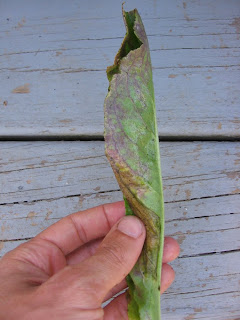This year we have been growing Woad & Weld for pigments. Last week we made our first attempt at processing pigment from a plant to moderate success. I am going to post some pictures from our Woad processing. Woad is also known as "Isatis Tinctoria" or "Dyers Woad". The dye chemical in Woad is the same chemical that makes the blue color in true indigo, but in a smaller concentration. Woad is in the same plant family as cabbage and mustard greens and grows much better here in Virginia than true indigo, a tropical plant, would.
Here is our pigment plot pre harvesting. The Woad plant we harvested is on the bottom left.
Cutting the leaves, much in the same way we harvest kale or other greens. We needed a plastic grocery bag full and we had exactly that.
The Woad needed to be washed well, first in the sink and then dipped in a bucket to make sure that as much dirt/sediment was removed as possible (so it would not be confused with the pigment sediment later).
You can see the blue in the leaves before processing! Now we just have to get that stuff out of there!
Sparing all of the details for this post, the woad has to be brought up to a specific temperature (see the candy thermometer in there?!) and kept there for 10 minutes. After that it must be iced in a bath to cool it down quickly (about 50 degrees in 5 minutes!). Once you reach the correct temperature the soda ash is added and the blue is created. If you add the soda ash when it is too hot you will destroy your blue. After this we got to aerate the bath with a mixer for ten minutes and watch it foam up bright green and then blue and back to green again. This was pretty exciting.
Once you have your liquid you pour it in jars and let the sediment settle down. Then every two hours or so you syphon out as much water as possible without disturbing the sediment on the bottom until you end up with one combined jar. Then you syphon some more! Then you add clear water and guess what... you syphon more again... until you have clear water over blue sediment. This is the pigment.
This is a brief description, the actual directions are much more technical. The directions we got said not to be discouraged if the first go was more of a grey blue, which is what our is. It probably means our plants need more nitrogen so we will fertilize more and hopefully the fall batch will be "blue-er". One curious thing is that our waste bath where we put everything we syphoned off had a bright blue streak in it when I poured it out! To be honest, we were kind of "blue" about that. (Sorry couldn't resist!) But seriously, where did that blue come from??!! Research research. We will post more serious directions once we have this thing down pat. Until then, behold our sediment...
After many hours of syphoning liquid with a turkey baster this was disproportionately exciting.
We also harvested our Weld, which yields a historical yellow pigment. Here is the plant in all of its glory:
It was all sprawly and attracted bees and flea beetles....
and then we cut it down! In this hot weather it dried to a crisp in less than two days. We will post more on this one once we process the pigment.










5 comments:
you guys are rad.
and my URL is mad outdated!
Thanks Jason! Sorry, will fix now... we are bad blog-keepers! :)
So hardcore!!!!
THIS IS AWESOME. YALL ARE AWESOME
Thanks dudes! :)
Post a Comment